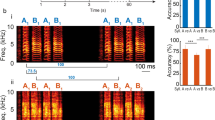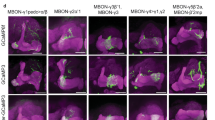Abstract
Odour representations in insects undergo progressive transformations and decorrelation1,2,3 from the receptor array to the presumed site of odour learning, the mushroom body4,5,6,7. There, odours are represented by sparse assemblies of Kenyon cells in a large population2. Using intracellular recordings in vivo, we examined transmission and plasticity at the synapse made by Kenyon cells onto downstream targets in locusts. We find that these individual synapses are excitatory and undergo hebbian spike-timing dependent plasticity (STDP)8,9,10 on a ±25 ms timescale. When placed in the context of odour-evoked Kenyon cell activity (a 20-Hz oscillatory population discharge), this form of STDP enhances the synchronization of the Kenyon cells’ targets and thus helps preserve the propagation of the odour-specific codes through the olfactory system.
This is a preview of subscription content, access via your institution
Access options
Subscribe to this journal
Receive 51 print issues and online access
$199.00 per year
only $3.90 per issue
Buy this article
- Purchase on Springer Link
- Instant access to full article PDF
Prices may be subject to local taxes which are calculated during checkout




Similar content being viewed by others
References
Mazor, O. & Laurent, G. Transient dynamics versus fixed points in odor representations by locust antennal lobe projection neurons. Neuron 48, 661–673 (2005)
Perez-Orive, J. et al. Oscillations and sparsening of odor representations in the mushroom body. Science 297, 359–365 (2002)
Wilson, R. I., Turner, G. C. & Laurent, G. Transformation of olfactory representations in the Drosophila antennal lobe. Science 303, 366–370 (2004)
deBelle, J. S. & Heisenberg, M. Associative odor learning in Drosophila abolished by chemical ablation of mushroom bodies. Science 263, 692–695 (1994)
Dubnau, J., Grady, L., Kitamoto, T. & Tully, T. Disruption of neurotransmission in Drosophila mushroom body blocks retrieval but not acquisition of memory. Nature 411, 476–480 (2001)
Yu, D., Keene, A. C., Srivatsan, A., Waddell, S. & Davis, R. L. Drosophila DPM neurons form a delayed and branch-specific memory trace after olfactory classical conditioning. Cell 123, 945–957 (2005)
Zars, T., Fischer, M., Schulz, R. & Heisenberg, M. Localization of a short-term memory in Drosophila. Science 288, 672–675 (2000)
Bi, G. Q. & Poo, M.-M. Synaptic modifications in cultured hippocampal neurons: dependence on spike timing, synaptic strength, and postsynaptic cell type. J. Neurosci. 18, 10464–10472 (1998)
Markram, H., Lubke, J., Frotscher, M. & Sakmann, B. Regulation of synaptic efficacy by coincidence of postsynaptic APs and EPSPs. Science 275, 213–215 (1997)
Roberts, P. D. & Bell, C. C. Spike timing dependent synaptic plasticity in biological systems. Biol. Cybern. 87, 392–403 (2002)
Clyne, P. J. et al. A novel family of divergent seven-transmembrane proteins: candidate odorant receptors in Drosophila. Neuron 22, 327–338 (1999)
Vosshall, L. B., Wong, A. M. & Axel, R. An olfactory sensory map in the fly brain. Cell 102, 147–159 (2000)
The. Honeybee Genome Sequencing Consortium. Insights into social insects from the genome of the honeybee Apis mellifera. Nature 443, 931–949 (2006)
MacLeod, K. & Laurent, G. Distinct mechanisms for synchronization and temporal patterning of odor-encoding neural assemblies. Science 274, 976–979 (1996)
Wehr, M. & Laurent, G. Odour encoding by temporal sequences of firing in oscillating neural assemblies. Nature 384, 162–166 (1996)
Jortner, R., Farivar, S. S. & Laurent, G. A simple connectivity scheme for sparse coding in an olfactory system. J. Neurosci. 27, 1659–1669 (2007)
MacLeod, K., Backer, A. & Laurent, G. Who reads temporal information contained across synchronized and oscillatory spike trains? Nature 395, 693–698 (1998)
Diesmann, M., Gewaltig, M. O. & Aertsen, A. Stable propagation of synchronous spiking in cortical neural networks. Nature 402, 529–533 (1999)
Vogels, T. P., Rajan, K. & Abbott, L. F. Neural network dynamics. Annu. Rev. Neurosci. 28, 357–376 (2005)
Arthur, J. V. & Boahen, K. Advances in Neural Information Processing. (eds Sholkopf, B. & Weiss, Y.) 75–82 (MIT Press, 2006)
Suri, R. E. & Sejnowski, T. J. Spike propagation synchronized by temporally asymmetric Hebbian learning. Biol. Cybern. 87, 440–445 (2002)
Zhigulin, V. P., Rabinovich, M. I., Huerta, R. & Abarbanel, H. D. Robustness and enhancement of neural synchronization by activity-dependent coupling. Phys. Rev. E 67, 021901 (2003)
Ultsch, A., Schuster, C. M., Laube, B., Betz, H. & Schmitt, B. Glutamate receptors of Drosophila melanogaster. Primary structure of a putative NMDA receptor protein expressed in the head of the adult fly. FEBS Lett. 324, 171–177 (1993)
Tanimoto, H., Heisenberg, M. & Gerber, B. Experimental psychology: event timing turns punishment to reward. Nature 430, 983 (2004)
Drew, P. J. & Abbott, L. F. Extending the effects of spike-timing-dependent plasticity to behavioral timescales. Proc. Natl Acad. Sci. USA 103, 8876–8881 (2006)
Frey, U. & Morris, R. G. Synaptic tagging: implications for late maintenance of hippocampal long-term potentiation. Trends Neurosci. 21, 181–188 (1998)
Leitch, B. & Laurent, G. GABAergic synapses in the antennal lobe and mushroom body of the locust olfactory system. J. Comp. Neurol. 372, 487–514 (1996)
Nowotny, T., Rabinovich, M. I., Huerta, R. & Abarbanel, H. D. Decoding temporal information through slow lateral excitation in the olfactory system of insects. J. Comput. Neurosci. 15, 271–281 (2003)
Blum, K. I. & Abbott, L. F. A model of spatial map formation in the hippocampus of the rat. Neural Comput. 8, 85–93 (1996)
Mehta, M. R., Lee, A. K. & Wilson, M. A. Role of experience and oscillations in transforming a rate code into a temporal code. Nature 417, 741–746 (2002)
Perez-Orive, J., Bazhenov, M., Stopfer, M. & Laurent, G. Intrinsic and circuit properties favor coincidence detection for decoding oscillatory input. J. Neurosci. 24, 6037–6047 (2004)
Acknowledgements
This work was supported by an NIH training grant, grants from the NIDCD, and the Lawrence Hanson Fund. We thank E. Schuman, I. Fiete, M. Murthy, M. Papadopoulou, O. Mazor, V. Jayaraman and the reviewers for their helpful comments.
Author information
Authors and Affiliations
Corresponding author
Ethics declarations
Competing interests
Reprints and permissions information is available at www.nature.com/reprints. The authors declare no competing financial interests.
Supplementary information
Supplementary Information
This file contains Supplementary Figure S1 with Legend which shows morphology of one bLN in the population studied (whole-mount). (PDF 1833 kb)
Rights and permissions
About this article
Cite this article
Cassenaer, S., Laurent, G. Hebbian STDP in mushroom bodies facilitates the synchronous flow of olfactory information in locusts. Nature 448, 709–713 (2007). https://doi.org/10.1038/nature05973
Received:
Accepted:
Published:
Issue Date:
DOI: https://doi.org/10.1038/nature05973
This article is cited by
-
Neural manifolds for odor-driven innate and acquired appetitive preferences
Nature Communications (2023)
-
Changes in the Spectral Characteristics and Level of Coherence of Local Field Potentials in the Rat Olfactory Bulb during Xylazine-Tiletamine-Zolazepam Anesthesia
Neuroscience and Behavioral Physiology (2023)
-
Neuronal avalanche dynamics regulated by spike-timing-dependent plasticity under different topologies and heterogeneities
Cognitive Neurodynamics (2023)
-
A neural theory for counting memories
Nature Communications (2022)
-
Phase-change memtransistive synapses for mixed-plasticity neural computations
Nature Nanotechnology (2022)
Comments
By submitting a comment you agree to abide by our Terms and Community Guidelines. If you find something abusive or that does not comply with our terms or guidelines please flag it as inappropriate.



